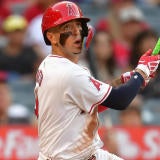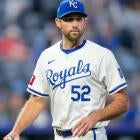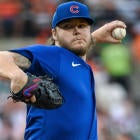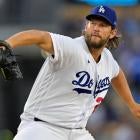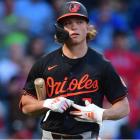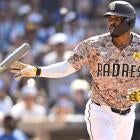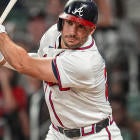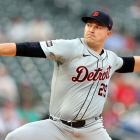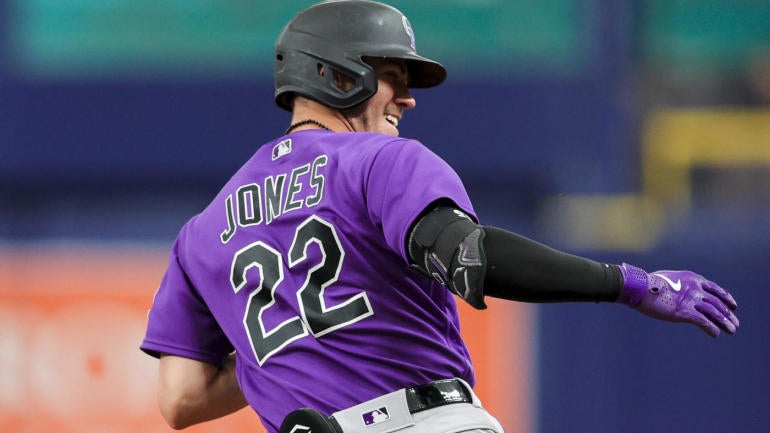
So you've come out of your Fantasy Football stupor and are ready to shake off the baseball cobwebs, are you? Good luck with that. While you pigged out on pigskin, another one-third of the season happened.
Maybe you didn't duck out at the earliest possible moment but instead when you were out of the running. Or perhaps your entire league decided to pack it in early, hoping to spare everyone the hardship of multitasking.
Whatever the case, you missed a lot, and clueing you in will require more than just an overview of the numbers. Fortunately, I had the foresight in October to chronicle all the biggest happenings from the final month-plus of the 2023 season, and I'm sharing it with you now, when you're actually able to hear it.
What better way to start on 2024 Draft Prep than to catch up on everything you should already know?
Prospect palooza
One year is a fluke. Two years is a trend, and the trend under the latest CBA seems to be for teams to call up their top prospects in September. They may not have a clear opening for them. They may not even be entirely sure they're ready. But if they want them to win a job next spring, they'll let them get their feet wet late the year before just so the task doesn't seem so daunting.
The incentives have changed in the past two years. While before, securing an extra year of control was paramount, encouraging teams to delay their biggest promotions until a month or two into a new season, now it's all about securing extra draft picks, which a prospect can accomplish if he places high enough in awards voting over the first few years of his career. But those incentives only come into play if he spends his entire rookie season on the major-league roster.
The Diamondbacks and Orioles laid the groundwork by promoting Corbin Carroll and Gunnar Henderson late in 2022, which allowed those two to hit the ground running in 2023, and both went on to win Rookie of the Year in his respective league.
Not every prospect called up late in 2023 is quite of their caliber, of course, but these are the ones who made the strongest impression for 2024 (while still preserving their rookie eligibility, of course):
- Junior Caminero came up for the final week of the season and remained on the roster into the postseason, making him an early Rookie of the Year favorite as a 20-year-old in 2024.
- Evan Carter looks underdeveloped physically, but the 21-year-old acclimated himself well, showing power and speed while reaching base at the high rate everyone expected.
- Noelvi Marte needs to work on elevating the ball, but he hit it incredibly hard and was aggressive on the base paths, giving him the inside track on the Reds' starting third base job this year.
- Ronny Mauricio suffered a torn ACL in the offseason, putting him out of the running for 2024, but he still looked great down the stretch last year, delivering the Mets' hardest-hit ball in his first major-league game while also racking up seven steals in just 26 games.
- Kyle Harrison made seven starts for the Giants, and though the results were mixed, he threw 65 percent of his pitches for strikes compared to 59 percent in the minors. If the left-hander has figured out control, the stuff will certainly play.
- Jordan Lawlar got the call pretty early in September but never really found his footing, and the Diamondbacks quickly lost interest in playing him. He'll get a long look this spring and compares favorably to Anthony Volpe.
- Sawyer Gipson-Long doesn't have a traditional power profile but nonetheless generated plenty of swings and misses with his slider and changeup, putting together a 2.70 ERA, 1.10 WHIP and 11.7 K/9 across four starts.
- Pete Crow-Armstrong went hitless in 14 at-bats, mostly serving as a pinch runner and defensive replacement. Still, he hit well enough in the minors to enter as the favorite for the starting center field job this spring, particularly if Cody Bellinger is indeed gone.
- Heston Kjerstad got a late call-up mostly as an atta boy for a job well done in the minors, but the Orioles have a real logjam of offensive talent right now. It's hard to know what to expect from either him or Colton Cowser in 2024.
- Wilyer Abreu was in and out of the lineup down the stretch but wound up slashing .316/.388/.474 with two home runs and three stolen bases, basically ensuring he'll be part of the Red Sox outfield mix against right-handers.
- Ceddanne Rafaela became a near-everyday player, splitting his time between center field and shortstop (oddly enough), and had enough good moments offensively to compete for a job even with Jarren Duran and Trevor Story back at full strength.
- Jasson Dominguez came up Sept. 1 and made an immediate splash, homering four times in eight games, but then he tore the UCL in his right eblow and wound up having Tommy John surgery. He'll be worth stashing for a midseason return.
- Masyn Winn came up as early as a prospect could while still retaining his rookie eligibility and got plenty of opportunities to stake his claim to the shortstop job, but he wound up hitting just .172. He'll have to earn it this spring.
- Austin Wells got a chance to serve as the Yankees' primary catcher over the final month and homered four times in 75 plate appearances. His left-handed swing is well-suited for Yankee Stadium, but whether he's up to the team's standards defensively remains to be seen.
- Curtis Mead has a world of talent offensively but is an awkward fit defensively on a team that rarely needs an excuse to reduce a player to part-time status.
- Joe Boyle's strikeout rates in the minors were only outdone by his walk rates, but he seemed far more composed across three major-league starts, delivering a 1.69 ERA, 0.81 WHIP and 8.4 K/9. He might get some late-round looks among the pitching-starved this year.
Others who came on strong
- Cole Ragans' best work came in August rather than September, but since he was just getting started around the time you turned your attention to football, you may be surprised to find out just how high he ranks for 2024. In his 11 starts once he was up for good, the left-hander with a robust five-pitch arsenal and occasional triple-digit fastball had a 2.70 ERA, 1.06 WHIP and 11.6 K/9.
- You may remember Nolan Jones was having an impact in limited chances with the Rockies, but he wound up being the decider of countless Fantasy championships, batting .349 (37 for 106) with seven homers and 12 steals in September. He recorded both his 20th home run and 20th stolen base on the final day of the season, making him a 20/20 man in just 106 games.
- Seiya Suzuki, who starred in Japan, always had the exit velocities to back up the hype, but it took until late in his second MLB season for the production to show up. From Aug. 1 on, the 29-year-old hit .350 (65 for 186) with 12 homers and a 1.073 OPS and may have found his footing finally.
- The two things that have hindered Mitch Garver over the years have been health and opportunity. The Rangers resolved both by making him their primary DH over the final six weeks. He started 40 of their final 43 games, which is far more than the average catcher-eligible player gets to play, and hit .283 (50 for 177) with 14 homers and a .937 OPS from Aug. 1 on, making him the third-best catcher in Fantasy during that stretch. He'll be the Mariners' primary DH in 2024.
- Royce Lewis came back from a strained oblique in late August and looked every bit like a former No. 1 overall pick, not only batting .295 (36 for 122) with 11 homers, five steals and a .992 OPS but also hitting four grand slams during that span. He hit another four home runs in six postseason games. Whatever questions remain about his health, the productivity is well established by now.
- In one of the more stunning developmental breakthroughs in recent memory, Ryan Pepiot went from walking everyone to walking no one in the span of one year. You want specifics? Over 28 appearances between the majors and minors in 2022, he issued 4.4 walks per nine innings. Over 14 appearances between the majors and minors in 2023, he issued 1.4 walks per nine innings. The sample is smaller because of the time he missed with an oblique injury, but it's enough to suggest that his 2.14 ERA and 0.76 WHIP for the Dodgers down the stretch was a legitimate breakthrough. The Rays are certainly bought in, accepting Pepiot as the key return in the Tyler Glasnow deal this offseason.
- Pepiot wasn't the only Dodgers hurler to leave a lasting impression Emmet Sheehan, who turned heads with his minor-league numbers early in the year but then thudded in his first big-league chance just before the All-Star break, hit his stride with a 1.98 ERA, 0.73 WHIP and 15.8 K/9 in his final three appearances, his fastball, slider and changeup all showing serious swing-and-miss potential. Meanwhile, Bobby Miller, who had the highest prospect standing of the three coming into the year, also saved his best for last, delivering a 3.19 ERA, 0.90 WHIP and 9.8 K/9 in his final six starts, three of which went seven innings.
- You remember Michael King, the high-leverage reliever who the Yankees toyed with making a closer from time to time? Turns out they made him a starter instead, giving him eight consecutive turns in the rotation to finish out the year, and it went about as smoothly as these transitions can. His velocity held even as his starts extended beyond four and five innings, and all four of his pitches got their time in the spotlight. The highlight was a 13-strikeout, no-walk effort Sept. 20 against the Blue Jays in which he allowed one run in seven innings, but for the entire eight-start experiment, King delivered a 1.88 ERA, 1.10 WHIP and 11.3 K/9. It was enough to make him one of the Padres' prime targets in the Juan Soto trade.
- Jake Burger's hot hitting after joining the Marlins continued through the end of the season, and he wound up batting .303 in 53 games with them compared to .214 in 88 games with the White Sox. It wasn't just happenstance. He made a point to tone down his swing, striking out just 21.7 percent of the time with the Marlins compared to 31.6 percent of the time with the White Sox.
- You may remember Cristopher Sanchez as that Phillies pitcher you streamed that one time, but nobody thought he had much of a future in Fantasy prior to September. He was, after all, a 26-year-old rookie with no prospect pedigree and mediocre minor-league numbers. But he finished with a walk rate that would have ranked fourth among qualifiers and a ground-ball rate that would have ranked second. His strikeout rate was decent considering, and his two 10-strikeout efforts in the season's final month showed just what a weapon his changeup could be
- Grayson Rodriguez's full season stats -- the 4.35 ERA, 1.34 WHIP and 9.5 K/9 -- tell one story. His stats after returning from a minor-league stint in mid-July -- the 2.58 ERA, 1.10 WHIP and 8.6 K/9 -- tell quite another. Both the strike-throwing and bat-missing picked up in his final six starts, resulting in a 1.80 ERA, 1.11 WHIP and 9.8 K/9.
- For all his prospect pedigree, though, Rodriguez may not be the first Orioles pitcher drafted in 2024, not with how good Kyle Bradish was down the stretch. Actually, "down the stretch" doesn't do it justice. Over the final three months, 16 starts in all, Bradish had a 2.14 ERA, 0.93 WHIP and 9.4 K/9, only three times allowing more than two earned runs and only twice lasting less than six innings (one of them being a two-inning tune-up outing on the final day of the season).
- Matt Wallner may have seemed like just a placeholder at first, but he played as regularly as any Twins outfielder down the stretch and hit some truly majestic home runs. In all, he had 14 in 254 plate appearances, batting .249 but living up to his three-true-outcomes profile with a .370 on-base percentage. He was actually at his best in September, slashing .284/.411/.513.
- Nelson Velazquez is another all-or-nothing bat, but his power is in higher demand in Kansas City. He seemed to thrive with regular playing time for the Royals, homering 14 times in 40 games (albeit with a .233 batting average).
- You might have written off TJ Friedl as an early-season blip if you tuned out in August, but September turned out to be his best month of the season. He hit .333 (27 for 81) with seven homers and three steals, likely ensuring he'll be drafted in all leagues this season.
- J.P. Crawford gave reason to believe he's a legitimate Fantasy asset, reaching base at .401 clip in the second half and hitting seven home runs in September. He finished as the 13th-best shortstop in points leagues and the 16th-best in Rotisserie.
- After a sluggish start to his big-league career, Christian Encarnacion-Strand finally found his power stroke with eight home runs in September. The 23-year-old who hit .322 with a .990 OPS over his minor-league career figures to play nearly every day with Joey Votto no longer under contract.
- Though Bo Naylor was up in the first half of the season, his biggest opportunity came in September, and he shined, batting .304 (17 for 56) with four homers, four steals and more walks (14) than strikeouts (10) for a .444 on-base percentage. His plate discipline and base-stealing prowess both set him apart among catchers, and his left-handedness shouldn't be too much of a hindrance since catchers sit a fair amount anyway.
- Willi Castro put himself in the running as a versatile late-round steals source by batting .313 (25 for 80) with four homers and four steals in September. He finished with 33 stolen bases overall.
- You may remember a mustachioed nobody named Davis Schneider coming up to go 9 for 13 with two home runs one weekend in August. He then disappeared for a while before coming back and doing more of the same. By Sept. 12 -- i.e., 25 games into his big-league career -- he was batting .370 (30 for 81) with eight homers and a .500 on-base percentage, but then he went 2 for 35 (.057) over his final 10 games. So it was a whole thing. Overall, he demonstrated a superlative batting eye and a swing that's built for home runs, yielding high fly-ball and pull rates. If nothing else, remember the name.
- Luis Campusano got some run as the Padres starting catcher finally after Gary Sanchez was lost to injury and looked good, batting .366 (26 for 71) with three homers in his final 20 games. Unfortunately, he himself went down with a sprained ankle before the year was done.
- As good as his slider is, Tigers rookie Reese Olson began to make better use of his changeup over the season's final month and delivered a 1.44 ERA in five starts, four of them lasting six innings or more.
- Nick Pivetta, who flirted with Fantasy greatness earlier in the year, ended the season on the highest possible note with back-to-back outings of seven scoreless innings. Between them, he allowed a combined five hits and two walks, striking out 17. From June 28 to the end of the season, he put together a 3.35 ERA, 0.97 WHIP and 12.9 K/9. He was bouncing between the bullpen and rotation during that time, but those final two starts probably secured what his role will be for 2024.
- Ke'Bryan Hayes more than doubled his previous high with 15 home runs, 10 of which came in the season's final two months. He had a 41.5 percent fly-ball rate during that time (to go along with a 92.3 mph average exit velocity). His career fly-ball rate is only 31.6 percent.
- Ryan Helsley and Tanner Scott were the two relievers who raised their stock the most in the season's final month. Helsley returned from a forearm injury to be the full-time closer he wasn't before it, recording a save in each of his final eight appearances while allowing just four hits and striking out 14. Scott, meanwhile, claimed the closer role from a collapsing David Robertson and recorded 10 saves in the final 31 games. He had a 1.42 ERA, 0.68 WHIP and 9.9 K/9 during that stretch.
Concerning developments
- Remember how twice in the span of about a week early in July, Corbin Carroll left a game grabbing his surgically repaired right shoulder in what looked to be a season-ending injury? Nothing more came of it, seemingly, but it should be noted that he homered just four times over the final two months compared to 21 times over the first four. The exit velocity readings were similar, and he was still productive overall. It's not a reason to pass him over early in Round 1 (he's my fourth overall pick in Rotisserie scoring), but I can't totally shake the feeling something is going on with that shoulder. It's worth noting that he added another two home runs in 17 postseason games.
- Fernando Tatis looked like he was hitting his stride heading into the All-Star break and would come out of it with numbers surpassing all but Ronald Acuna. Instead, he hit .225 with a .665 OPS. His overall numbers aren't so bad considering -- a lot of credit should go to a player who delivers 25 homers and 29 steals after a season lost to wrist and shoulder surgeries, not to mention a PED suspension -- but it's reasonable to wonder if the effects of that tumultuous 2022 will linger beyond just the 2023 season.
- You hear the name Bo Bichette and think first round, but what if I told you he slashed .287/.317/.438 over the final four months, 79 games in all? Hardly first-round material, is it? You might think the stolen bases would make up, but no, he had just five of those all year, declining from 25 to 13 to five over the last three seasons. The success rate has been terrible, too. If we can't count on Bichette to be a base-stealer anymore, then he'll need to be rock solid for power, which he clearly wasn't in 2023.
- Though he finished with 28 homers and 20 steals, surprise standout Lane Thomas hit just .223 (61 for 274) in the second half compared to .302 (107 for 354) in the first. But you probably saw that coming, right?
- Things came so easily for Andrew Abbott at first, with a 1.90 ERA over his first 10 starts, that you may be surprised to discover where his numbers wound up. Even as late as Aug. 22, his ERA was 2.99, but he fully spiraled thereafter, delivering a 6.43 ERA and 1.89 WHIP in his final seven starts. Was it because he had exceeded his previous high in innings, or was it the inevitable outcome for a pitcher who struggles with walks, hard contact and fly balls? Maybe some of both, but it does make the 2024 assessment for Abbott more complicated.
- Trevor Story opted for an internal bracing procedure on his right elbow rather than full-blown Tommy John, which allowed him to come back before the season was done, but his return didn't do anything to alleviate our concerns. He hit only .203 (32 for 158). He homered just three times in 168 plate appearances. He struck out at an outrageous 32.7 percent rate. On the plus side, his exit velocities weren't terrible, and he really took to the new stolen base environment, swiping 10 bags in that same span of time. But you can't feel the least bit confident in what you're getting from the 31-year-old in 2024.
- After looking like he had taken a step forward as a hitter in the first half, Randy Arozarena collapsed in the second half, batting .220 (52 for 236) with seven homers and a .700 OPS. He ended up placing behind Nick Castellanos in 5x5 categories leagues and behind Ian Happ in points leagues.
- Nate Lowe hit just .160 (17 for 106) in September, putting a miserable end to a disappointing season. Between that and him batting .223 (43 for 193) with a .642 OPS against left-handers, he may not be a lock for everyday duty moving forward.
- Sean Murphy never did regain his stroke in the second half, batting .159 (22 for 138) with just four home runs, and in fact became the Braves' lesser-used option behind the plate in September. His Statcast page is still fire, and you'd be hard-pressed to name 10 catchers with more upside offensively. Hopefully, the Braves give him more consistent playing time in 2024, when Travis d'Arnaud will be 35.
- Ezequiel Duran homered just twice in the entire second half, batting .226 (36 for 159).
- Though Spencer Strider is likely to be the top pitcher drafted in Fantasy because he's such an outlier for strikeouts, he didn't do himself any favors with a 5.67 ERA over his final six starts. His overall ERA climbed 40 points during that span, finishing at 3.86.
- Justin Steele also had a bumpy finish that took him out of the running for NL Cy Young, his ERA climbing from 2.49 to 3.06 over his final three starts. His 3.48 xERA and 3.32 xFIP suggest that it may have been just the start of his regression.
- To whatever degree you considered Bryce Elder a Fantasy asset, you can stop. The ground-ball specialist with little swing-and-miss in his arsenal went from having a 2.45 ERA in his first 17 starts to a 5.75 ERA in his final 14.
- Hunter Greene had his high points after returning from a hip injury in late August -- such as a seven-inning, 14-strikeout effort on Sept. 20 -- so clearly, the ability is still there. But in all, he had a 6.52 ERA in his eight starts back at full health.
- You were probably witness to Carlos Rodon's bumpy return from a forearm strain, but I'm sorry to say it didn't get any better from there. His final start saw him allow eight earned runs without recording an out -- at Kansas City, no less -- bringing his ERA to 6.85.
- Michael Brantley completed his long recovery from shoulder surgery and got some starts down the stretch, mostly at the expense of Chas McCormick, one of the Astros' big breakout players of 2023. When asked about McCormick's diminished playing time, manager Dusty Baker said "he ain't a big boy yet." McCormick finished just a stolen base shy of a 20/20 season. Fortunately, Brantley has since retired.
- You may have tuned out thinking Lucas Giolito was having a bounce-back season given that he entered August with a 3.85 ERA. He had just joined the Angels then and made six starts for them before being waived and claimed by Cleveland, where he wasn't any better. Between the two teams, Giolito had a 6.96 ERA in 12 starts. His final 4.88 ERA was just two points off from his 4.90 mark in 2022.
- Hunter Brown's impressive rookie season took a turn in July and just kept getting worse from there. Over the final three months, he had a 6.95 ERA, his overall ERA climbing from 3.62 to 5.09.
- There was a point midseason when Christian Yelich looked like he might be regaining something close to his former MVP form, but he ended up homering just three times in the final two months. His bout with back soreness first came to light in late August, and it seems like just a given now at this stage of his career.
Sighs of relief
- It would be fair to say Juan Soto didn't live up to his draft position for a second straight year, but he went a long way toward correcting that in the month when the fewest people were paying attention, batting .340 (33 for 97) with 10 homers and six steals. Between that and his move to the Yankees in the offseason, you can expect to pay a first-round price for the 25-year-old again.
- Xander Bogaerts also did his best in September to salvage a disappointing season with the Padres, batting .418 (43 for 103) with four homers and six steals. It brought him to within both a home run and a stolen base of his first-ever 20/20 season. He ultimately ranked 10th among shortstops in points scoring and 12th in 5x5 -- and that's even with an absurdly low RBI total (58) over what was the third-most plate appearances (665) in his career.
- Trea Turner sank to such depths in his first season with the Phillies that an epic finish wasn't quite enough to salvage his stat line, but an epic finish is what he had. Depending on when exactly you tuned out, you last saw him at either his absolute low point or when he was just beginning to turn things around. He ended up hitting .317 (65 for 205) with 16 homers, nine steals and a 1.000 OPS over the final two months. It had as much as anything to do with him tightening up his zone, swinging at more pitches in it and fewer pitches out of it. Seems like the pressures of a new contract might have led him to chase more early on.
- You may not bat an eye at Bryce Harper being drafted in Round 2 next year just because he's Bryce Harper, but rest assured, it's not some great leap of faith. After homering five times in his first three months back from the quickest-ever rehabilitation from Tommy John surgery, he homered 16 times in the next two months back, slashing .299/.425/.641.
- Depending on when you tuned out, Michael Harris' turnaround from his miserable start to 2023 may not have peaked yet. His final slash line (.293/.331/.477) ended up being nearly identical to 2022 slash line (.297/.339/.514). He also finished with exactly the same number of stolen bases (20) and was only one off in home runs (18 vs. 19). OK, so he had nearly 100 more plate appearances and still bats in the lower third of the Braves lineup more than anyone would like, but the point is that his 2023 turned out to be more validating than it appeared at first.
- J.D. Martinez hit .333 (27 for 81) with eight homers and 25 RBI in September, bringing him to 33 homers and 103 RBI for the year. That's impressive enough for a player the Dodgers pulled off the scrap heap last offseason, but even more impressive is that he did it in just 113 games.
- MJ Melendez overcame a miserable start to the year with a pretty strong finish, slashing .273/.352/.485 with 10 homers in the second half. Unfortunately, he'll no longer be catcher-eligible at the start of 2024.
- You may have seen Freddy Peralta begin to turn his season around with a 13-strikeout effort against the Reds on July 26. Turns out he was basically a league-winner from that point forward, delivering a 2.44 ERA, 0.85 WHIP and 13.2 K/9 over his final 11 starts. It's been a bit of a roller coaster since his breakthrough 2021, but you won't find many pitchers with more upside than that.
Other notable performances
- There should no longer be any questions about the sort of leash the Tigers will give Tarik Skubal. The left-hander went six innings or more in six of his final eight starts, putting together a 1.88 ERA, 0.73 WHIP and 12.4 K/9. Mark him down as an early Cy Young sleeper.
- Seeing as his batting average hovered in the .250 range most of the year, you may be shocked to learn that Matt Olson, in addition to leading the majors in home runs (54) and RBI (139), also batted a career-high .283. That's because he hit .321 in the second half, striking out just 18.4 percent of the time compared to 27.0 percent in the first half.
- Marcell Ozuna homered twice and drove in four runs on the final day of the season to finish with exactly 40 homers and 100 RBI. He hit .297 from May 1 on, but his April was so miserable that it pulled his season mark down 25 points, to .274.
- A 17-for-22 stretch in mid-August raised Julio Rodriguez's batting average by 22 points, from .256 to .278, and by the end of August, he was batting .286. He seemed destined to beat his rookie mark of .284, which would have been a remarkable turnaround for a player who was still batting in the .230s at the end of June, but a 1-for-24 stretch to close out the year brought it down to .275. Whatever you take from that, it was quite a ride.
- After a scintillating start to his big-league career, Elly De La Cruz went on to hit .200 (39 for 195) over the final two months, striking out 34.5 percent of the time. That's the bad news. The good news is that his 18 stolen bases still made him the 13th-best shortstop in 5x5 leagues and the 17th-best in points leagues during that time, which tells you a little bit about his floor.
- Similarly, Ha-seong Kim hit just .176 in September but managed to salvage it with nine stolen bases. He finished with 17 homers and 38 steals overall.
- Yoan Moncada hit .298 with six home runs in September. Does it mean anything? I'm betting no, but since he's a 28-year-old who was a must-start third baseman in the not-so-distant past, it seemed worth bringing up.
- Sonny Gray had a 2.03 ERA, 0.93 WHIP and 9.2 K/9 over his final 11 starts. It's not the first time we've seen such a stretch from him, and it's unlikely he's turned over a new leaf at age 33. But you should know that he led all qualifiers, even Spencer Strider, with a 2.83 FIP.
- Bobby Witt finished just a stolen base shy of the fourth-ever 30-homer, 50-steal season. Ronald Acuña was the third to join that club earlier in the year and in fact finished with 41 homers and 73 steals.
- John Means, Shane Bieber, Frankie Montas, Triston McKenzie, Hyun-Jin Ryu all returned from extended absences to make at least one appearance before season's end. The most notable performer among them was Means, who had a 2.66 ERA and 0.72 WHIP in four starts, but he also struck out just 10 in 23 2/3 innings.
Lingering health concerns
- Clayton Kershaw returned in mid-August from a six-week absence for a shoulder injury, but he never seemed quite right, his velocity lagging 2-3 mph across the board. He was still fairly effective considering, actually lowering his ERA, but was of little consequence in Fantasy because he only once made it beyond five innings (going 5 1/3 in his final start of the season). He remains unsigned this offseason, furthering speculation that we've seen him pitch for the last time.
- Turns out Manny Machado was playing most of the year with tennis elbow, which might explain why he fell a bit short of our expectations. September was actually one of his best months of 2023 -- he hit .321 with five home runs -- but even so, he opted for surgery as soon as the season ended, putting his availability for Opening Day in question.
- All seemed right in the world of Brandon Woodruff when last you left him. He had come back from a four-month absence for a shoulder capsular strain and delivered a 2.59 ERA, 0.81 WHIP and 10.0 K/9 over his final nine starts, positioning himself once again as a top-10 starting pitcher for 2024. But then just before the postseason, the Brewers announced he would be unavailable because of another injury to his shoulder capsule. He has since undergone surgery and is expected to miss all of 2024, actually being non-tendered by the Brewers this offseason.


